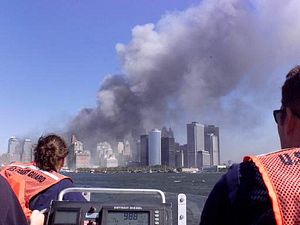Semper paratus. Over at USNI News, Sam LaGrone recounts a little-remembered episode from September 11: how the U.S. Coast Guard cobbled together a makeshift fleet that evacuated nearly half a million people from Battery Park and its environs. That’s at the extreme southern tip of Manhattan Island, where sightseers catch tour boats out to the Statue of Liberty, Ellis Island, and other scenic spots.
Doubtless Manhattan’s tourist precincts were packed on that splendid September morning. Getting people out was a mammoth undertaking. For comparison’s sake, the number of evacuees withdrawn from Manhattan represents about half-again as many soldiers as a ragtag fleet pulled out of Dunkirk in 1940. That’s when Hitler’s army backed a combined French, Belgian, and British contingent up against the sea, threatening to annihilate a sizable fraction of Allied combat power. Public and private craft, large and small, descended on coastal France to rescue the troops.
Dunkirk, in short, was one of history’s greatest pickup games. (As it happens, another took place in 1776, when George Washington’s army managed to flee from Long Island to Manhattan, escaping destruction at Redcoat hands.) Was coping with 9/11 easy compared to Dunkirk? I suppose it turned out that way. No Nazi horde skulked around New York’s outskirts, waiting to strike. The evacuation didn’t take place under fire. But remember, that’s more than emergency responders or the rest of the country knew at the time. We all assumed the next blow was about to fall — if not in New York or Washington, then somewhere. So let’s give the ad hoc fleet its due. Those were harrowing times for improvising a noncombatant evacuation.
The occasion for retelling this tale now, 13 years after the fact? The U.S. Naval Institute just published an oral history from Admiral James Loy, then serving as America’s senior coast guardsman. Admiral Loy relates his part in the 9/11 response. Rather than claim credit for the success, though, he pays tribute to the local Coast Guard commanders and senior enlisted mariners who oversaw the endeavor. Then, as always, on-scene leadership made the difference.
So why didn’t people just walk out of the afflicted zone when airliners slammed into the Twin Towers? Because of the city’s strategic geography. Manhattan is narrow, a finger of an island. The attack scene lay just to the north, blocking the obvious escape routes — namely the streets running north and south. Nor could those trapped south of the World Trade Center easily make their way around to the east, joining those who trudged across the Brooklyn Bridge onto Long Island.
That left water. Would-be evacuees confronted a stark choice: swim off the island, or embark in boats and ships. The Staten Island Ferry, Governor’s Island Ferry, and a hodgepodge of small boats joined U.S. Coast Guard craft in the operation. This on-the-fly public/private partnership reaffirms certain verities about maritime pursuits. For one, sea power can encompass any vessel capable of taking to the sea. Not just hulking warships and coast-guard cutters but merchantmen, fishing boats, and pleasure craft can render good service in times of peril. It’s not all about navies and coast guards.
For another, even vibrant seafaring nations need adjunct fleets of the 9/11 sort from time to time. No government boasts unlimited resources to invest in a navy and coast guard. That means no sea service can police all important waters at the same time. That’s doubly true of a continent-spanning republic like the United States, or an archipelagic nation like Japan or Indonesia. These are countries with distended shorelines. It takes time, toil, and organization to concentrate fragmented maritime forces at points of impact — even along your own coasts. (See Katrina, Hurricane.)
Think about it. New York Harbor is a center of sea power once a year, for a few days during Fleet Week. I remember parading past the Twin Towers in 1991. Maritime resources were abundant that fine June. Apart from that, navy and coast guard forces are spread thin along American coastlines, on the logic that it’s better to forward-deploy many small units close to potential trouble spots rather than mass a few larger units farther away. Balancing concentration with dispersal of forces, then, poses a timeless quandary in disaster and humanitarian relief — just as it does when battling a powerful enemy.
And lastly, ships and boats don’t pilot themselves. Officialdom needs a populace that stands ready to help out. If no government can police every place on national territory at all times, the corollary is that ordinary people may have to shift for themselves until the cavalry arrives. Americans take pride in the minuteman spirit on display at Lexington and Concord, when regular citizens took up arms to combat aggression. A century later, New York City native Theodore Roosevelt deemed America’s frontier heritage salutary because it engraved the habit of self-reliance on the national character. And so forth.
Such cultures are worth nurturing not just for their own sake but because traits favoring self-help prime regular citizens to lend a hand when disaster strikes — perhaps at significant hazard and expense to themselves. Spontaneity is good. Seafarers of the world, unite!

































